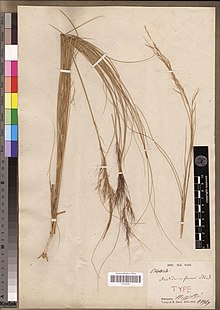| Aristida rufescens | |
|---|---|

| |
| Type specimen at the MNHN | |
|
Scientific classification
| |
| Kingdom: | Plantae |
| Clade: | Tracheophytes |
| Clade: | Angiosperms |
| Clade: | Monocots |
| Clade: | Commelinids |
| Order: | Poales |
| Family: | Poaceae |
| Genus: | Aristida |
| Species: | A. rufescens
|
| Binomial name | |
| Aristida rufescens | |
| Synonyms | |
|
Aristida multicaulis Baker | |
Aristida rufescens is a grass species native to Madagascar and to Mayotte in the Comoros archipelago. [3] It was described by German agrostologist Ernst Gottlieb von Steudel in 1854. [1]: 421 [2]
The species is a perennial bunch grass with short rhizomes. Its culms are erect and 70–100 centimetres (28–39 in) long, with swollen nodes and hairy leaf sheaths. Leaf blades are 30–40 centimetres (12–16 in) long and 3 mm wide; they are stiff, leathery, and convolute. The inflorescence is a panicle in which each spikelet contains one fertile flower. Spikelets are lanceolate and 8.5 mm long. Upper and lower glumes have 1–2 mm long awns, and lateral lemmas have a 13–14 mm long awn, [4] which is three-branched. [5]: 27 The grass is a C4 plant. [6]
Aristida rufescens is one of the dominant species in the grasslands of the central high plateaus of Madagascar. [6] [7] It is extremely fire-tolerant; although of poor quality when mature, young resprouts after fire are protein-rich cattle feed in the September to November "hungry season". In Malagasy, it is known locally as horona, horombohitra, kofafa vavy, horombavy, or pepeka. It is used for roofing and broom-making, [8] and its ash for medical ointments. [5]: 27
References
- ^ a b von Steudel, E.G. (1854). Synopsis Plantarum Glumacearum (in Latin). Vol. 1. Stuttgart: J. B. Mezler. OCLC 488692713.
- ^ a b "Tropicos - Aristida rufescens Steud". Retrieved 4 March 2018.
- ^ "World Checklist of Selected Plant Families - Aristida rufescens Steud., Syn. Pl. Glumac. 1: 421 (1854)". Retrieved 24 March 2018.
- ^ Clayton, W.D.; Vorontsova, M.S.; Harman, K.T.; Williamson, H. "Aristida rufescens". GrassBase - The Online World Grass Flora. Royal Botanic Gardens, Kew. Retrieved 4 March 2018.
- ^ a b Vorontsova, M.S.; Dransfield, S.; Renvoize, S.; Besnard, G.; McRobb, A.; Razanatsoa, J.; Prisca, N.O.; Rakotoarisoa, S.E.; Ralimanana, H. (2018). Identification guide to grasses and bamboos in Madagascar. Richmond, Surrey: Royal Botanic Gardens, Kew. ISBN 9781842466483.
- ^ a b Bond, W.J.; Silander Jr, J.A.; Ranaivonasy, J.; Ratsirarson, J. (2008). "The antiquity of Madagascar's grasslands and the rise of C4 grassy biomes". Journal of Biogeography. 35 (10): 1743–1758. doi: 10.1111/j.1365-2699.2008.01923.x. ISSN 0305-0270. S2CID 67777752.
- ^ Moat, J.; Smith, P. (2007). Atlas of the vegetation of Madagascar. Richmond, Surrey: Royal Botanic Gardens, Kew. ISBN 9781842461983.
- ^ Kull, C.A. (2003). "Fire and the management of highland vegetation". In Goodman, S.M.; Benstead, J.P. (eds.). The natural history of Madagascar. Chicago, London: The University of Chicago Press. pp. 153–157. ISBN 978-0226303079.